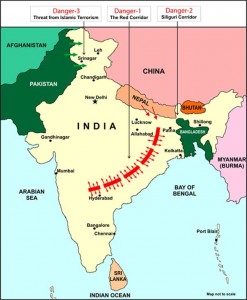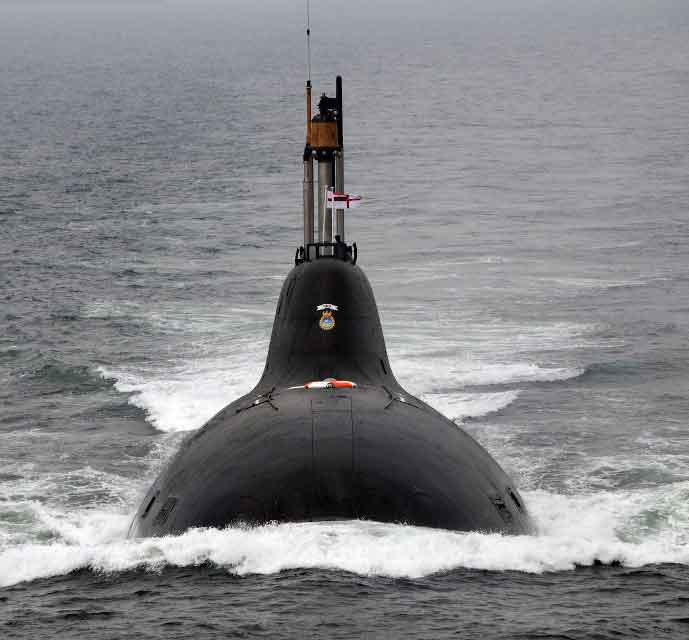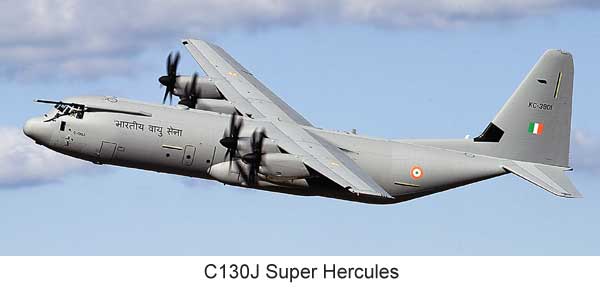How India can acquire great power status?
Due to New Delhi’s slavish use of ‘carrot’ since Independence, without any equilibrium with the ‘stick’, the great power potential of India lies in tatters.
In fact it threatens to endanger the writ on its territory. Between Naxals in the Red Corridor, Border States particularly the J&K and the Northeast, New Delhi‘s writ barely runs in fifty per cent of its territory.
With the failure to govern within, there is an automatic rollback of influence of central and state governments towards their respective capitals.
With the failure to govern within, there is an automatic rollback of influence of central and state governments towards their respective capitals. This lopsided use of ‘carrot’ has emboldened neighboring countries like China, Nepal (Maoists), Pakistan, and Bangladesh to execute a sly rollback of the Indian Union on its borders through ingress, territorial claims, occupation of Indian territory, infiltration, export of Islamic terrorism and demographic assault. Simultaneous shrinking of influence without and within is sowing seeds of disintegration of the Union.
 If only one element is used in the policy of “carrot and stick” it creates an enormous imbalance and upheaval. This can easily be discerned in the illogical use of the ‘stick’ alone by Washington’s neo-conservatives. Without balancing it with the ‘carrot’ has created unprecedented turmoil for the western alliance, dented American aura, created a divide within, and sapped the societal confidence.
If only one element is used in the policy of “carrot and stick” it creates an enormous imbalance and upheaval. This can easily be discerned in the illogical use of the ‘stick’ alone by Washington’s neo-conservatives. Without balancing it with the ‘carrot’ has created unprecedented turmoil for the western alliance, dented American aura, created a divide within, and sapped the societal confidence.
India has clear potential of achieving a great power status. Unlike the negative demographic young profile in its neighborhood, it boasts of a highly skilled young population. Its geographical location and the size lend it the advantages of both, a continental as well as maritime power which, make it possible for New Delhi to impact and influence West Asia, Southeast Asia and the Central Asia.
However, this is only possible if instead of being an inward looking nation, New Delhi’s footprints extend outwards. Inward looking entities tend to wither away as their influence shrinks. This in particular is true of India that faces a 14,000 km wall (on its land frontiers) of fundamentalist/authoritarian regimes.
Despite India’s geographical location and human resources bestowing on it all the advantages that can develop it as the Asian hub of liberal values, the manufacturing gateway, and the research base for cutting edge technologies, it continues to waste its potential of achieving a great power status due to skewed policy making, indecision and inconsistency.
It is absolutely vital for India to achieve dominance in Asia so that it can engage constructively with the totalitarian regimes in its vicinity without losing its poise and balance.
To be a great power, the Indian aim should be to establish its preponderance over Asia. Broadly, this requires three decisive steps.
- 1st, set your own house in order.
- Second, develop political, economic, military, and technological dominance in your vicinity.
- Third, create international alliances without forming a formal block, based on the age-old principal of “enemy’s enemy is a friend.”
New Delhi and the state capitals must ruthlessly endeavour to recover the territories lost internally to Naxals; mafias in the crime corridor; and terrorists and insurgents in its borders areas. In other words, government’s writ and influence through transparent and fair governance must fan outwards to recover the lost territories within.
To recover internal territory from the non-state actors, New Delhi will have to learn to force development down the throat at gunpoint in Naxal affected and border areas. Rapid improvement of the infrastructure in Border States through the private sector will in effect rupture the internal links with the external forces determined to subvert the Union. To achieve this policing has to be beefed up, modernized, well paid, just, firm, and apolitical. This is one institution that needs transformation in its entirety, if the waning writ of the state has to be restored.
Similarly, consolidate and integrate the Union instead of dividing and compartmentalizing it for the sake of vote bank politics. It is amazing that in a globalized world, an Indian needs an inner line permit to visit certain parts of his own country. He is refused permission to buy property and settle down in various locations. But the Islamic terrorist from across the border freely parks himself in border areas, merrily changes the demography with impunity, and estabilishes terrorist training camps in Karnataka forests! New Delhi fiddles while the Union continues to sink under the weight of Islamic terrorism and strident territorial claims by China.
It is amazing that in a globalized world, Indian needs a inner line permit to visit certain parts of his own country
An average Indian at heart is a capitalist — a trader, a businessman, and an entrepreneur. His mantra simply is “What’s in it for me?” This is one reason why the Indian community is the top money earner in the United States. Encourage his ability and dream to create individual wealth that transforms ultimately into a national asset. Understanding of this societal characteristic by the government is paramount in ushering in good governance.
The authoritarian regimes across our land borders have more in common with each other than a liberal India. In addition, the creeping Wahabism in Malaysia; the upsurge in fundamentalism in Thailand and Indonesia; and the possibility of West Asia being taken over by the Jehadis should trouble New Delhi’s conscience. The emerging scenario will prove to be a boon to the authoritarian and expansionist China and increase its influence exponentially. Sixty years of doling out ‘carrots’ leaves India pretty much alone, with even Nepal increasingly falling into the hands of Maoists who are in cahoots with the Chinese.
Surrounded by an array of adversaries, therefore, the key question for New Delhi is how to outgun them?
Surrounded by an array of adversaries, therefore, the key question for New Delhi is how to ‘outgun’ them? How about developing a large ‘stick’? Sure, that’s the way out.
Let me spell out as to what is likely to happen if we do not.Beijing in shrewd moves to tie New Delhi in knots will continue to instigate and boost countries like Pakistan to subvert India. While China may not attack India initially, it will subvert our vicinity by gaining leverage over Bhutan and Nepal besides the other surrogates with whom it enjoys special relationship already.
Finally, it will aim for the jugular — the Northeast, and will be willing to share a portion of it with Bangladesh to end India’s writ in its entirety beyond the Siliguri corridor. After that Bhutan and Nepal will be at its mercy. If Beijing can gain its objectives through asymmetric warfare, then there is little need for an intelligent nation to wage conventional war. The Chinese call this a peaceful rise! Besides their expansionist outlook, the outward flow of influence also helps to divert attention from the brewing internal turmoil.
If Beijing can gain its objectives through asymmetric warfare, then there is little need for a intelligent nation to wage conventional war. The Chinese call this a peaceful rise!
If we are farsighted by bringing ‘stick’ in balance with the ‘carrot’, New Delhi can counter Beijing. Collapse of Pakistan is almost certain. India should ensure that China’s proxy Pakistan disintegrates. This handicaps China by taking away one of its arms out of the two, the other being North Korea. The buildup towards collapse of Pakistan should see New Delhi initiating moves to deny Gawdar port facilities to China by leveraging existing goodwill in Baluchistan. Simultaneously, it needs to work towards opening up of the route to Central Asia. Our connectivity and influence in that region is mandatory as historically all major invasions were mounted from there, as also a large portion of oil and gas from 2010 will be sourced from Central Asia and Iran.
To be a great power, India must also learn to shoulder its share of global responsibility. Be willing to station two divisions worth of troops in Afghanistan to defend millions of dollars of taxpayer’s money being invested in reconstruction programme there. Otherwise Taliban ultimately will walk away with the investment!
Similarly in consultation with Bhutan, India must beef up it’s military presence there, otherwise the small steps of democracy that Thimpu is taking will be reversed by Beijing.
Methodology to widen the narrow 8 to 21-km-wide and 200-km-long Siliguri corridor to at least 150 km on either side, also needs to be worked out.
The air force should attain lethal reach so that it is able to damage the new railway line to Tibet and thus deny the vital supply line in case of war.
To achieve strategic goals outlined, preponderance of the Indian military power posturing outwards is a virtual necessity. To hone the wherewithal, rapid decision-making on multiple fronts needs to be activated simultaneously.
To achieve strategic goals outlined, preponderance of the Indian military power posturing outwards is a virtual necessity.
The Leftists recently betrayed Beijing’s anxiety at ramifications of New Delhi signing the Indo-US Nuclear Deal. China is deeply concerned, as India will race ahead within the next fifteen years, making itself the Asian hub of the cutting edge technologies. Some of the most modern and sensitive technologies in possession of the western world are today on offer to New Delhi and not to Beijing.
Therefore, India must sign the Indo-US Nuclear Deal. The deal’s lateral spin offs to strengthen India’s political, economic, and military positions in Asia are immense. It is absolutely vital for India to achieve dominance in Asia so that it can engage constructively with the totalitarian regimes in its vicinity without losing its poise and balance.
Some of the most modern and sensitive technologies in possession of the western world are today on offer to New Delhi and not to Beijing.
To enhance and modernize the military prowess, the annual defence budget should be pegged at 3.5 per cent of the GDP for the next ten years. To heighten the stakes of foreign companies in India, increase the FDI limits to 49 per cent from existing 26 per cent. New Delhi can leverage this in reverse in the international community. To hasten the emergence of India as the leading Asian defence research and manufacturing hub, induct the Indian private sector to take up the manufacturing of aircraft, warships, missiles, etc. either individually, or in joint ventures with the multinationals. Deep technology transfers should be the first preference in ‘offsets’. In my view, the proposed public-private sector partnerships are hogwash and an unnatural marriage!
The deteriorating standards of the military, both in terms of human resources and the equipment, require to be reversed. In fact, the increasing security threats dictate that the military power apart from being lean and mean, should be enhanced by another fifty per cent.
The deteriorating standards of the military, both in terms of human resources and the equipment, require to be reversed.
The shortfall of young officers who provide the cutting edge in wars and the ageing profile of commanding officers upwards can be checkmated by simple decisive measures. New Delhi should encourage short service commissioned officers a tenure of seven years, with a gratuity packet at the end, of Rs. 25 lacs, two years of post graduation facility in any university in the world at the government cost, guaranteed lateral induction with assured service seniority into police, para-military forces, and the civil administration, etc. This artificial shortage will disappear.
Further, encourage lateral induction of the top-heavy military into civil services and restore the original sanctity of the rank structure to reverse the ageing profile.
It is also time that we created a Strategic Affairs Cell in the MoD under the Defence Secretary, headed by a three-star general or equivalent with representatives of the three services and an experienced foreign service officer. The Indian Armed Forces need to be led by a five-star CDS for a meaningful strategic attitude.
The Indian Armed Forces need to be led by a five-star Chief of Defence Staff for a meaningful strategic attitude.
Once Washington removes the inherent flaws and establishes a balance between the ‘stick and the carrot’, America will recover a fair amount of lost ground within a few years because of its insulated geographical location, extraordinary resources, and the quality of governance it delivers to its citizens. New Delhi, unlike Washington is neither geographically placed in a secure environment nor has its leadership exhibited the genius of good governance.
To avoid heading the way Pakistan is going and to realise its full potential, India will have to learn to use the ‘stick’ in tandem with the ‘carrot’. With unique geopolitical opportunities that exist for India on the international chessboard due to it’s inherent strengths in several areas, to reach for the sky should not be all that difficult!




No comments:
Post a Comment